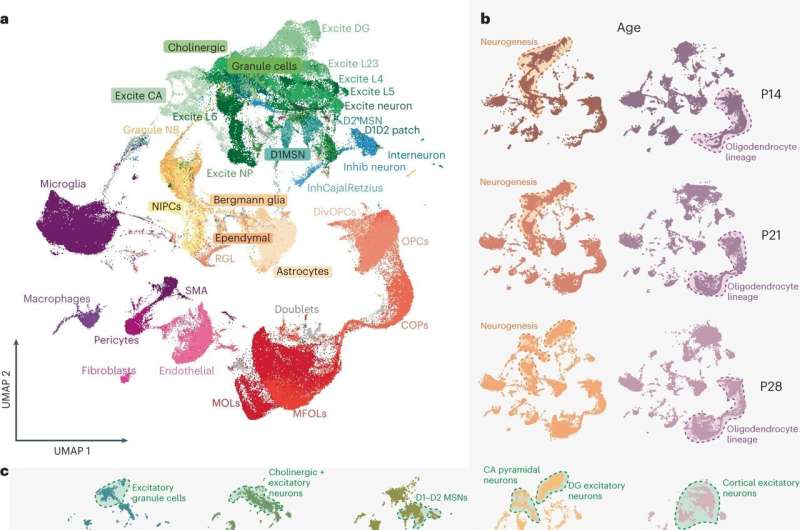This article has been reviewed according to Science X's editorial process and policies. Editors have highlighted the following attributes while ensuring the content's credibility:
fact-checked
peer-reviewed publication
trusted source
proofread
New atlas of mRNA variants captures inner workings of the brain

Investigators at Weill Cornell Medicine have assembled the most comprehensive atlas to date of messenger RNA (mRNA) variants in the mouse and human brain. The atlas is an important new resource in understanding brain development, neuron specialization and other brain functions.
RNA transcripts that are copied from DNA sequences carry the instructions for building proteins and show which genes are active in a particular cell. When a gene is copied into a raw RNA transcript, it usually can be processed in different ways to form distinct splice variants or isoforms; thus, a single gene may produce several different proteins.
Although this complex layer of biology is thought to hold the keys to understanding many otherwise mysterious diseases—especially in the brain—detailing it has been a tremendous technical challenge.
In their study, published in Nature Neuroscience, the researchers used cutting-edge sequencing methods to record the mRNA isoforms present in the mouse and human brain—in different brain regions, different cell types and different growth stages in the mice. They found that even within a given cell type, the isoforms for some genes varied considerably depending on where the cell resides and the stage of the brain's development.
"It's definitely a big step forward, allowing us now to examine processes in the brain in more detail," said study senior author Dr. Hagen Tilgner, associate professor of neuroscience in the Center for Neurogenetics of Weill Cornell Medicine's Feil Family Brain and Mind Research Institute.
The first author, Dr. Anoushka Joglekar, was a doctoral candidate who worked in the Tilgner lab during the study and was co-mentored by Dr. Elizabeth Ross, Nathan E. Cumming Professor of Neurology and Neuroscience and director of the Center for Neurogenetics at Weill Cornell Medicine. Dr. Joglekar is now a postdoctoral researcher at the New York Genome Center, a research institute co-founded by 14 New York academic institutions, including Weill Cornell Medicine.
The 'fine print'
Isoform variation is part of the "fine print" of biology; thus, it is inherently hard to read. This is mainly because standard RNA-sequencing technology cannot reliably detect differences between mRNA isoforms. To address this issue, the researchers turned to more expensive and time-consuming "long read" sequencing, which still required significant data processing to achieve sufficient accuracy.
They performed this massive undertaking in a manner that recorded each individual cell and the long-read RNA sequences it produces. This allowed the researchers to identify isoforms from hundreds of thousands of individual mouse and human brain cells.
The resulting atlas, which builds on datasets from smaller studies by the same team in 2018 and 2021, will serve as a basic reference for neuroscientists studying normal and abnormal brain function and development. Already, the team's initial analyses of their data yielded some surprises that will be followed up in future investigations.
The researchers found, for example, that for many genes important in neuron-to-neuron signaling, the same cell type expressed different mRNA isoforms in different brain regions. Variation was even more pronounced during adolescence when many isoforms exhibited unexpected patterns of fluctuation.
"We saw that some of these isoforms get switched on and off all through development until they reach stability in adulthood," Dr. Joglekar said.
The team also observed that many of the genes with highly variable isoforms had been linked, in prior genetic studies, to major brain disorders, including Alzheimer's, Parkinson's, schizophrenia, bipolar disorder, anxiety, and depression.
Although most of the findings for the mouse and human brain cells were similar, the researchers plan to focus on human cells in future studies—comparing, for example, isoform variation in normal aging and in aging-related brain disorders.
More information: Anoushka Joglekar et al, Single-cell long-read sequencing-based mapping reveals specialized splicing patterns in developing and adult mouse and human brain, Nature Neuroscience (2024). DOI: 10.1038/s41593-024-01616-4


















